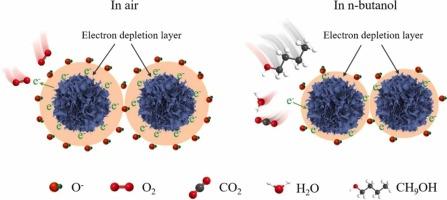The enhanced n-butanol gas sensing properties based on perovskite-type ZnSnO3 nanoflowers
IF 3.7
1区 化学
Q1 CHEMISTRY, ANALYTICAL
引用次数: 0
Abstract
N-butanol is a volatile organic compound (VOC) that is harmful to human health, and the development of gas sensors for n-butanol vapor detection is necessary. In this work, the nanoflowers-like ZnSnO3 was synthesized via a one-step hydrothermal route followed by an annealing process. The results revealed that optimizing the hydrothermal time to 12 hours resulted in ZnSnO3-2 exhibiting the highest gas response (40.48) towards 100 ppm n-butanol at 275°C, boasting a detection limit of 500 ppb. Furthermore, ZnSnO3-2 exhibits excellent gas selectivity and long-term stability. The improved sensing performance of ZnSnO3-2 was attributed to its large specific surface area and abundant oxygen vacancies. Additionally, the gas sensing mechanism for enhancing n-butanol detection was comprehensively analyzed. These results highlight the potential of nanoflower-like ZnSnO3 as a promising candidate for n-butanol gas sensing material, offering both high sensitivity and selectivity. Moreover, this research provides valuable guidance for the development and optimization of gas sensing materials for applications in environmental monitoring and industrial safety.

钙钛矿型ZnSnO3纳米花增强正丁醇气敏性能
正丁醇是一种对人体有害的挥发性有机化合物(VOC),开发用于正丁醇蒸气检测的气体传感器是非常有必要的。本文采用一步水热法合成了纳米花状的ZnSnO3,然后进行了退火处理。结果表明,优化水热时间为12 h时,ZnSnO3-2在275℃下对100 ppm正丁醇的气体响应最高(40.48),检测限为500 ppb。ZnSnO3-2具有优异的气体选择性和长期稳定性。ZnSnO3-2的传感性能的提高主要归功于其较大的比表面积和丰富的氧空位。此外,还对气敏增强正丁醇检测的机理进行了全面分析。这些结果突出了纳米花样ZnSnO3作为正丁醇气体传感材料的潜力,它具有高灵敏度和选择性。此外,该研究为环境监测和工业安全领域气敏材料的开发和优化提供了有价值的指导。
本文章由计算机程序翻译,如有差异,请以英文原文为准。
求助全文
约1分钟内获得全文
求助全文
来源期刊

Sensors and Actuators B: Chemical
工程技术-电化学
CiteScore
14.60
自引率
11.90%
发文量
1776
审稿时长
3.2 months
期刊介绍:
Sensors & Actuators, B: Chemical is an international journal focused on the research and development of chemical transducers. It covers chemical sensors and biosensors, chemical actuators, and analytical microsystems. The journal is interdisciplinary, aiming to publish original works showcasing substantial advancements beyond the current state of the art in these fields, with practical applicability to solving meaningful analytical problems. Review articles are accepted by invitation from an Editor of the journal.
 求助内容:
求助内容: 应助结果提醒方式:
应助结果提醒方式:


